Related Research Articles

The Big Dig was a megaproject in Boston that rerouted the then elevated Central Artery of Interstate 93 that cut across Boston into the O'Neill Tunnel and built the Ted Williams Tunnel to extend Interstate 90 to Logan International Airport. Those two projects were the origin of the official name, the Central Artery/Tunnel Project. Additionally, the project constructed the Zakim Bunker Hill Bridge over the Charles River, created the Rose Kennedy Greenway in the space vacated by the previous I-93 elevated roadway, and funded more than a dozen projects to improve the region's public transportation system. Planning for the project began in 1982; the construction work was carried out between 1991 and 2006; and the project concluded on December 31, 2007. The project's general contractor was Bechtel and Parsons Brinckerhoff was the engineer, who worked as a consortium, both overseen by the Massachusetts Highway Department.

Stonehenge is a prehistoric megalithic structure on Salisbury Plain in Wiltshire, England, two miles (3 km) west of Amesbury. It consists of an outer ring of vertical sarsen standing stones, each around 13 feet (4.0 m) high, seven feet (2.1 m) wide, and weighing around 25 tons, topped by connecting horizontal lintel stones. Inside is a ring of smaller bluestones. Inside these are free-standing trilithons, two bulkier vertical sarsens joined by one lintel. The whole monument, now ruinous, is aligned towards the sunrise on the summer solstice and sunset on the winter solstice. The stones are set within earthworks in the middle of the densest complex of Neolithic and Bronze Age monuments in England, including several hundred tumuli.
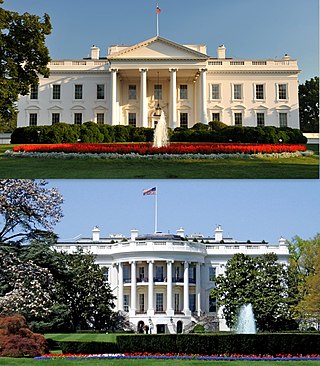
The White House is the official residence and workplace of the president of the United States. Located at 1600 Pennsylvania Avenue NW in Washington, D.C., it has served as the residence of every U.S. president since John Adams in 1800 when the national capital was moved from Philadelphia. The term "White House" is often used as a figure of speech for the president and his advisers.
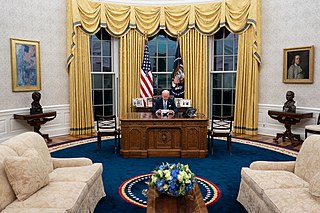
The Oval Office is the formal working space of the president of the United States. Part of the Executive Office of the President of the United States, it is in the West Wing of the White House, in Washington, D.C.
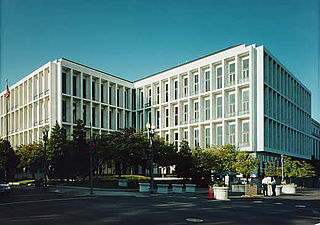
The Philip A. Hart Senate Office Building is the third U.S. Senate office building, and is located on 2nd Street NE between Constitution Avenue NE and C Street NE in Washington, D.C., in the United States. Construction began in January 1975, and it was first occupied in November 1982. Rapidly rising construction costs plagued the building, creating several scandals. The structure is named for Philip Hart, who served 18 years as a senator from Michigan. Accessed via a spur of the United States Capitol Subway System, the building features a nine-story atrium dominated by massive artwork, and a large Central Hearing Facility which provides television facilities as well as extensive seating.
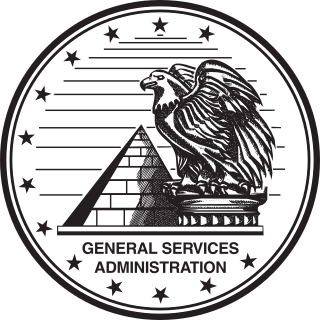
The General Services Administration (GSA) is an independent agency of the United States government established in 1949 to help manage and support the basic functioning of federal agencies. GSA supplies products and communications for U.S. government offices, provides transportation and office space to federal employees, and develops government-wide cost-minimizing policies and other management tasks.
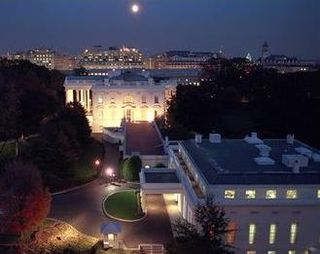
The West Wing of the White House houses the offices of the president of the United States. The West Wing contains the Oval Office, the Cabinet Room, the Situation Room, and the Roosevelt Room.

The J. Edgar Hoover Building is a low-rise office building located at 935 Pennsylvania Avenue NW in Washington, D.C., in the United States. It is the headquarters of the Federal Bureau of Investigation (FBI).

The William Jefferson Clinton Federal Building is a complex of several historic buildings located in the Federal Triangle in Washington, D.C., across 12th Street, NW from the Old Post Office. The complex now houses the headquarters of the Environmental Protection Agency (EPA).

East Potomac Park is a park located on a man-made island in the Potomac River in Washington, D.C., United States. The island is between the Washington Channel and the Potomac River, and on it the park lies southeast of the Jefferson Memorial and the 14th Street Bridge. Amenities in East Potomac Park include the East Potomac Park Golf Course, a miniature golf course, a public swimming pool, tennis courts, and several athletic fields. The park is a popular spot for fishing, and cyclists, walkers, inline skaters, and runners heavily use the park's roads and paths. A portion of Ohio Drive SW runs along the perimeter of the park.
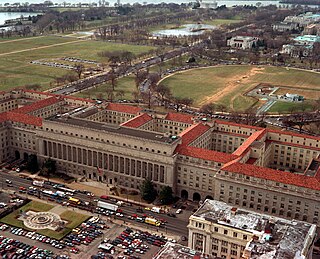
The Herbert C. Hoover Building is the Washington, D.C. headquarters of the United States Department of Commerce.

The President's House in Philadelphia was the third U.S. Presidential Mansion. George Washington occupied it from November 27, 1790, to March 10, 1797, and John Adams occupied it from March 21, 1797, to May 30, 1800.

The Old Post Office, listed on the National Register of Historic Places as the Old Post Office and Clock Tower, is located at 1100 Pennsylvania Avenue, N.W. in Washington, D.C. It is a contributing property to the Pennsylvania Avenue National Historic Site. The building's 315-foot (96-meter) high clock tower houses the "Bells of Congress," and its observation level offers panoramic views of the city and its surroundings. A historic federal office building, it now serves as a hotel.

The United States Courthouse, also known as the Federal Building, is a historic building located in Davenport, Iowa, United States. It has historically housed a post office, courthouse, and other offices of the United States government. The building now serves only as a federal courthouse, housing operations of the eastern division of the United States District Court for the Southern District of Iowa. In 2018, the operations of the Rock Island division of the United States District Court for the Central District of Illinois were also moved there.

The Federal Building and Post Office is a historic main post office, courthouse, and Federal office building at 271-301 Cadman Plaza East in the Downtown Brooklyn neighborhood of Brooklyn in New York City. The original building was the Brooklyn General Post Office, and is now the Downtown Brooklyn Station, and the north addition is the courthouse for the United States Bankruptcy Court for the Eastern District of New York, and is across the street from and in the jurisdiction of the main courthouse of the United States District Court for the Eastern District of New York, the Theodore Roosevelt United States Courthouse. It also houses offices for the United States Attorney, In 2009, the United States Congress renamed the building the Conrad B. Duberstein United States Bankruptcy Courthouse, after chief bankruptcy judge Conrad B. Duberstein.

The James V. Forrestal Building is a low-rise Brutalist office building in Washington, D.C. Originally known as Federal Office Building 5, and nicknamed the Little Pentagon, the Forrestal Building was constructed between 1965 and 1969 to accommodate United States armed forces personnel. It is named after James Forrestal, the first United States Secretary of Defense. It became the headquarters of the United States Department of Energy after that agency's creation in 1977.

The desk in the Vice President's Ceremonial Office in the Eisenhower Executive Office Building, colloquially known as the Theodore Roosevelt desk, is a large mahogany pedestal desk in the collection of the White House. It is the first of six desks that have been used by U.S. presidents in the Oval Office, and since 1961 has been the used as the desk of the U.S. Vice President.

Brian Mosteller is an American diplomat and operations executive, best known for being the Director of Oval Office Operations in the Obama administration, from 2009 to 2017.

The White House to Treasury Building tunnel is a 761-foot (232 m) subterranean structure in Washington, D.C. that connects a sub-basement of the East Wing of the White House to the areaway which surrounds the United States Treasury Building. It was initially constructed in 1941 to allow the evacuation of the president from the White House to underground vaults inside the Treasury in an emergency.

The Ted Weiss Federal Building, also known as the Foley Square Federal Building, is a 34-story United States Federal Building at 290 Broadway in the Civic Center neighborhood of Lower Manhattan in New York City. Opened in 1994, the building was developed by Linpro New York Realty and designed by Hellmuth Obata & Kassabaum (HOK), with Raquel Ramati Associates as the design consultant and Tishman Construction as the general contractor. The building is named for Ted Weiss (1927–1992), a U.S. representative from New York.
References
- ↑ "White House 'Big Dig': West Wing entrance fenced off". The Washington Post . Associated Press. 4 April 2011. Retrieved 25 January 2016.
- 1 2 Smith, Mark (12 September 2012). "White House Big Dig Remains A Mystery As Construction Wraps Up". Huffington Post . Associated Press . Retrieved 25 January 2016.
- ↑ Storey, Will (17 October 2011). "Big Hole in White House Lawn Prompts Equally Big Questions". The New York Times . Retrieved 25 January 2016.
- ↑ Davenport, Christian (27 November 2011). "In the Nation's Capital, Underground is Where it's At". The Washington Post . Retrieved 25 January 2016.
- ↑ "Mysterious White House Hole". ABC News . Retrieved 25 January 2016.
- ↑ Simendinger, Alex (1 February 2013). "2nd Oval Office Readied in White House Rehab Project". Real Clear Politics . Retrieved 25 January 2016.
- ↑ Boyer, Dane (6 February 2013). "Clone Oval Office Report Denied". Washington Times . Retrieved 25 January 2016.